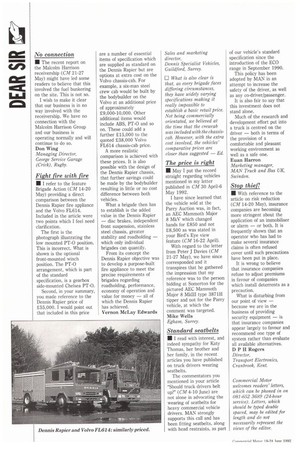• The recent report on the Malcolm Harrison receivership (CM
Page 46

If you've noticed an error in this article please click here to report it so we can fix it.
21-27 May) might have led some readers to believe that this involved the fuel bunkering on the site, This is not so.
I wish to make it clear that our business is in no way involved with the receivership. We have no connection with the Malcolm Harrison Group and our business is operating normally and will continue to do so.
Don Wing Managing Director, George Service Garage (Crick), Rugby.
Fight fire with fire
• I refer to the feature Brigade Action (CM 14-20 May) providing a direct comparison between the Dennis Rapier fire appliance and the Volvo FL614. Included in the article were two points which I feel need clarification.
The first is the photograph illustrating the low mounted PT-0 position. This is incorrect. What is shown is the optional front-mounted winch position. The PT-0 arrangement, which is part of the standard specification, is a gearbox side-mounted Chelsea PT-0. Second, in your summary, you made reference to the Dennis Rapier price of £55,000. I would point out that included in this price are a number of essential items of specification which are supplied as standard on the Dennis Rapier but are options at extra cost on the Volvo chassis-cab, For example, a six-man steel crew cab would be built by the bodybuilder on the Volvo at an additional price of approximately £9,000-10,000. Other additional items would include ABS, PT-0 and so on. These could add a further £15,000 to the quoted £38,000 Volvo FL614 chassis-cab price.
A more realistic comparison is achieved with these prices. It is also possible with the design of the Dennis Rapier chassis, that further savings could be made by the bodybuilder resulting in little or no cost difference between both vehicles.
What a brigade then has to establish is the added value in the Dennis Rapier — disc brakes, independent front suspension, stainless steel chassis, greater stability and roadholding — which only individual brigades can quantify.
From its concept the Dennis Rapier objective was to develop a purpose-built fire appliance to meet the precise requirements of brigades regarding roadholding, performance, economy of operation and value for money — all of which the Dennis Rapier has achieved.
Vernon McLay Edwards Sales and marketing director, Dennis Specialist Vehicles, Guildford, Surrey.
LI What is also clear is that, as every brigade faces differing circumstances, they have widely varying specifications making it really impossible to establish a basic retail price. Not being commercially orientated, we believed at the time that the crewcab was included with the chassiscab. However, with the extra cost involved, the vehicles' comparative prices are closer than suggested — Ed.
The price is right
• May I put the record straight regarding vehicles mentioned in my letter published in CM 30 April-6 May 1992.
I have since learned that the vehicle sold at the Parry Auction was, in fact, an AEC Mammoth Major 8 MkV which changed hands for £850 and not £8,500 as was stated in your Bird's Eye view feature (CM 16-22 April).
With regard to the letter from Peter J Davies (CM 21-27 May), we have since corresponded and it transpires that he gathered the impression that my reference was to the person bidding at Somerton for the pictured AEC Mammoth Major 8 MkIII type 3871H tipper and not for the Parry vehicle, at which the comment was targeted. Mike Wells Egham, Surrey.
Standard seatbelts
• I read with interest, and indeed sympathy for Katy Thomas, her brother and her family, in the recent articles you have published on truck drivers wearing seatbelts.
The commentators you mentioned in your article "Should truck drivers belt up?" (CM 4-10 June) are not alone in advocating the wearing of seatbelts for heavy commercial vehicle drivers. MAN strongly supports this call and has been fitting seatbelts, along with head restraints, as part of our vehicle's standard specification since the introduction of the ECO range in September 1990.
This policy has been adopted by MAN in an attempt to increase the safety of the driver, as well as any co-driver/passenger.
It is also fair to say that this investment does not stand alone.
Much of the research and development effort put into a truck is centred on the driver — both in terms of the provision of a comfortable and pleasant working environment as well as a safe one.
Euan Harron Marketing manager, MAN Truck and Bus UK, Swindon.
Stop thief!
II With reference to the article on risk reduction (CM 14-20 May), insurance companies are becoming more stringent about the application of an immobiliser or alarm — or both. It is frequently shown that an operator who has had to make several insurance claims is often refused cover until such precautions have been put in place.
It is wrong to believe that insurance companies refuse to adjust premiums in favour of companies which install deterrents as a precaution.
What is disturbing from our point of view — because we are in the business of providing security equipment — is that insurance companies appear largely to favour and recommend one type of system rather than evaluate all available alternatives. D P H Rogers Director, Transport Electronics, Cranbrook, Kent




















































































